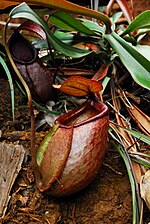
Nepenthes sibuyanensis is a tropical pitcher plant endemic to Sibuyan Island in the Philippines, after which it is named.

Nepenthes truncata is a tropical pitcher plant endemic to the Philippines. It is known from the islands of Dinagat, Leyte, and Mindanao. The species grows at an elevation of 0–1500 m above sea level. Nepenthes truncata is characterised by its heart-shaped (truncate) leaves and very large pitchers, which can reach up to 40 cm in height.

Nepenthes burkei, named after British plant collector David Burke, is a tropical pitcher plant native to the island of Mindoro in the Philippines, where it grows at an elevation of 1100–2000 m. It is very closely related to N. sibuyanensis and N. ventricosa. It has only recently entered wider cultivation.

Nepenthes alata is a tropical pitcher plant endemic to the Philippines. Like all pitcher plants, it is carnivorous and uses its nectar to attract insects that drown in the pitcher and are digested by the plant. It is highly polymorphic, and its taxonomy continues to be subject to revisions.
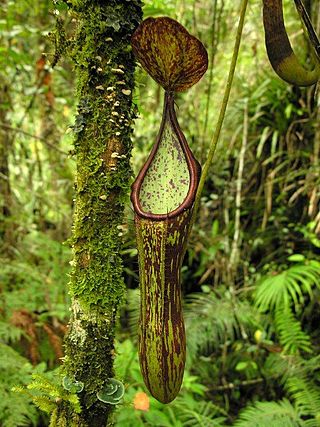
Nepenthes copelandii is a species of pitcher plant native to the island of Mindanao in the Philippines. Originally known from Mount Apo near Davao City and Mount Pasian near Bislig, it has since been discovered on a number of peaks throughout Mindanao. It may also be present on the nearby island of Camiguin. The species has a wide altitudinal distribution of 1100–2400 m above sea level. Nepenthes copelandii has no known natural hybrids. No forms or varieties have been described.
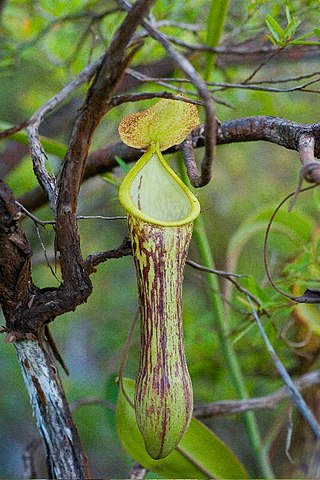
Nepenthes mindanaoensis is a tropical pitcher plant native to the Philippine islands of Mindanao and Dinagat.

Nepenthes philippinensis is a tropical pitcher plant endemic to the Philippines. It is known from Palawan and the neighbouring Calamian Islands and Linapacan, where it grows at 0–600 metres (2,000 ft) above sea level.
Nepenthes saranganiensis is a tropical pitcher plant native to the Philippine island of Mindanao. It is noted for its extremely decurrent leaf attachment that extends a large distance down the stem, often continuing into the next internode.
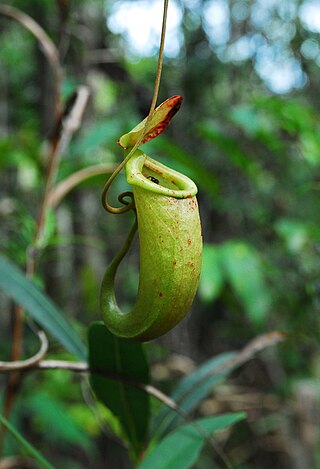
Nepenthes bellii is a tropical pitcher plant endemic to the Philippine islands of Mindanao and Dinagat, where it grows at elevations of 0–800 m above sea level.

Nepenthes mira is a highland pitcher plant endemic to Palawan in the Philippines. It grows at elevations of 1550–1605 m above sea level.

Nepenthes petiolata is a highland Nepenthes pitcher plant species endemic to Mindanao island in the Philippines, where it grows at an elevation of 1,450–1,900 metres (4,800–6,200 ft) above sea level.

Nepenthes surigaoensis is a tropical pitcher plant endemic to the Philippine island of Mindanao, where it grows at elevations of at least 800–1200 m above sea level.

Nepenthes graciliflora is a tropical pitcher plant endemic to the Philippines. Long considered a synonym of N. alata, it was restored as a separate species in 2013 by Martin Cheek and Matthew Jebb. It has been recorded from the islands of Bohol, Leyte, Luzon, Mindanao, Mindoro, Panay, Samar, and Sibuyan, and following the redelimitation of N. alata is the most widespread Nepenthes species of the Philippines. It is known from mossy, submontane forest, generally at 800–1,280 metres (3,000–4,000 ft) altitude, though the type specimen from Sibuyan was collected at only 300 m (1,000 ft).
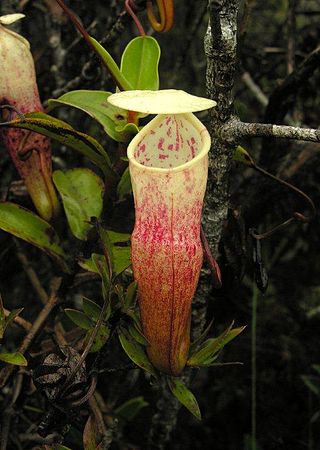
Nepenthes alba is a tropical pitcher plant endemic to Peninsular Malaysia. The specific epithet alba is derived from the Latin word albus, meaning "white", and refers to the colour of the upper pitchers.

Nepenthes ceciliae is a tropical pitcher plant endemic to the Philippine island of Mindanao, where it grows at 1500–1880 m above sea level. Its discovery was announced online in August 2011.

Nepenthes ramos is a tropical pitcher plant native to the northeastern Mindanao, Philippines. It is known from only a handful of herbarium specimens collected in 1919 at an elevation of 670 m above sea level. It likely grows in the forest on ultramafic soils.
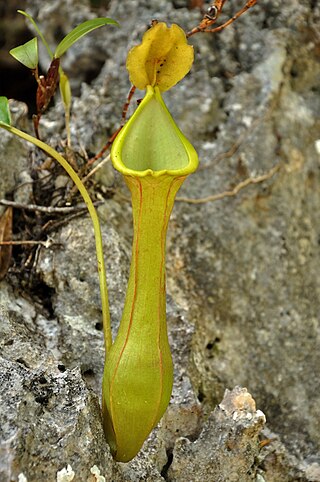
Nepenthes viridis is a tropical pitcher plant endemic to the Philippines. It is known only from coastal areas at low altitude and has been recorded from Dinagat, Samar, and a number of surrounding islets. It is closely allied to the N. alata group of species.




